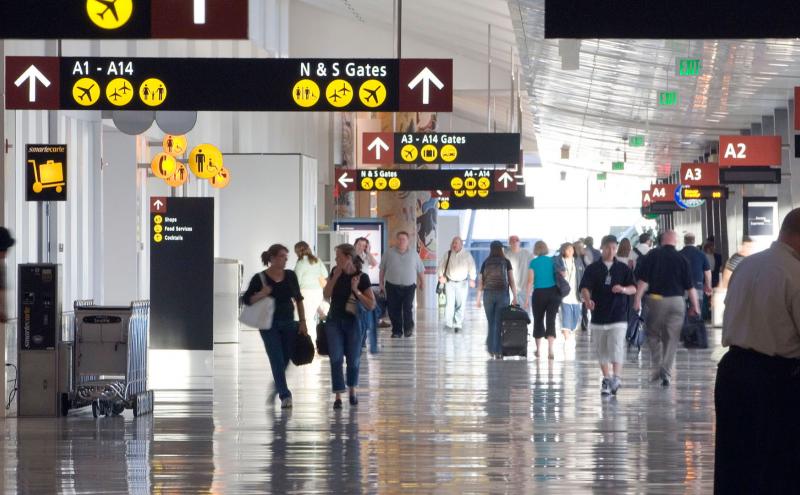
The Port of Seattle and Sea-Tac Airport are celebrating a number one ranking for reducing its carbon footprint.
Seattle-Tacoma International Airport is the first airport in North America to be certified for reducing carbon emissions by a world-wide independent program. A special ceremony over the weekend honored Sea-Tac with Level 2 certification under Airport Council International’s (ACI) Airport Carbon Accreditation (ACA) program.
“This is a significant step to be recognized world-wide for the conservation and environmental stewardship programs we have instituted at Sea-Tac Airport,” said Port of Seattle Commission Co-President Stephanie Bowman. “Next year we expect to go even further in the certification as part of our Century Agenda goal to reduce aircraft-related emissions by 25 percent at Sea-Tac and 50 percent overall at the Port of Seattle.”
There are now 86 airports certified in Europe, 20 in Asia-Pacific, and 1 in Africa since the program was launched in 2009. Sea-Tac is the first airport in North America to be certified as the ACI-NA (North America) Board recently decided to adopt the program and launched it at its annual meeting in Atlanta this week.
Overall, Sea-Tac demonstrated an eight percent reduction in airport terminal carbon emissions in just three years through energy efficiencies and low-carbon electricity. In that three year span, Sea-Tac Airport has reduced its annual electricity consumption by more than 7,750,000 kWh (7.8 MWh) per year, which is the equivalent amount of electricity that 700 single-family homes would consume in a year. A typical home in the U.S. consumes about 11,000 kWh per year.
In total, there are 4 different levels of ACA certification. Level 1 is carbon mapping; Level 2 is demonstrated carbon reductions; Level 3 is demonstrated reductions plus “optimization” with partners; and Level 3+ is carbon neutrality.
Recent newly instituted environmental programs are expected to easily push Sea-Tac to the Level 3 certification including:
- Electric Ground Service Equipment (eGSE) – providing nearly 600 electric charging stations to convert service equipment from diesel to electric, such as baggage tugs, ramps and pushback vehicles, with projected annual savings of $2.8 million in fuel costs and 10,000 tons of greenhouse gas emissions,
- Centralized Pre-Conditioned Air for aircraft parked at gates will save $15 million in airline fuel costs and 40,000 metric tons of greenhouse gases (began operation in July 2013),
- 48 Electric Vehicle Charging stations in the airport garage is the most of any airport in North America (added 2010 through late 2013),
- A fleet of clean, compressed natural gas (CNG) buses moves customers between the terminal and the Rental Car Facility saving 165,000 vehicle trips per month versus single rental car shuttles (opened 2012),
- Requirements for taxis serving the airport to use CNG vehicles or have high efficiency engines of 45 miles per gallon or better (2011),
- A centralized off-aircraft recycling system of large capacity, computer-monitored compactors that reduces waste sent to landfills, decreases air emissions, improves ramp safety, saves more than $250,000 each year and reduces pickup trips by 75% (2010).
ACA has been formally recognized by a number of key international organizations including: The European Civil Aviation Conference (ECAC) and EUROCONTROL, the International Civil Aviation Organization (ICAO), and the United Nations Environment Programme (UNEP).
More details about ACA Certification can be found here: http://www.airportcarbonaccreditation.org/
About Seattle-Tacoma International Airport
Operated by the Port of Seattle, Seattle-Tacoma International Airport (SEA, KSEA) is ranked as the 15th busiest U.S. airport, serving more than 34.7 million passengers and more than 292,000 metric tons of air cargo in 2013. With a regional economic impact of more than $13.2 billion in business revenue, Sea-Tac generates more than 138,000 jobs (89,902 direct jobs) representing more than $2.2 billion in direct earnings and $412.4 million in state and local taxes. Twenty-four airlines serve 71 non-stop domestic and 19 international destinations.
The Port of Seattle is setting the course for the future with the Century Agenda. In 25 years, we will generate 100,000 new jobs and increase international trade and tourism, while protecting the environment with innovative sustainability initiatives. Learn more about how the region’s economic engine will keep powering King County’s economy for years to come!

